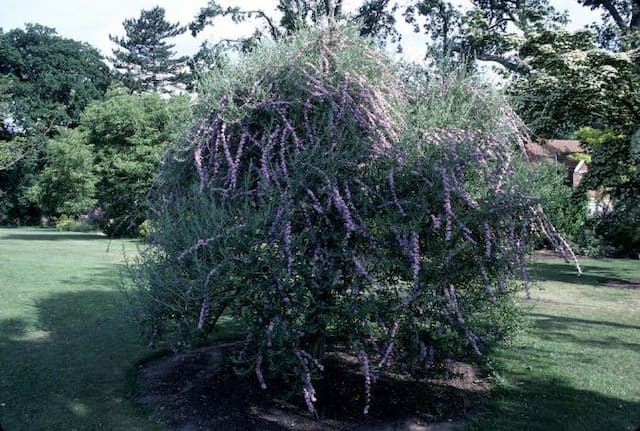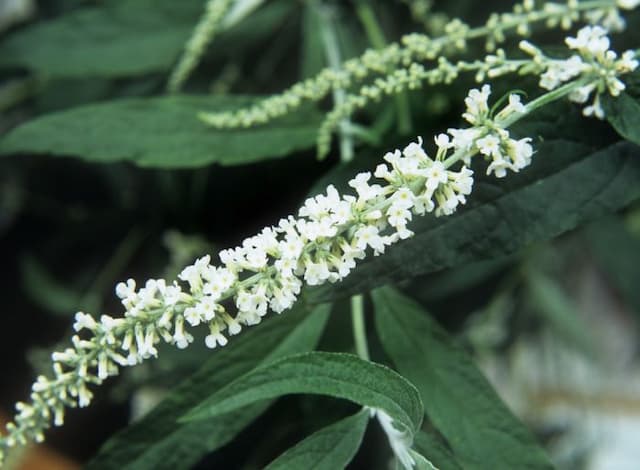Great Mullein Verbascum densiflorum






ABOUT
Verbascum densiflorum, commonly known as the denseflower mullein or dense-flowered mullein, is a plant that is well recognized for its striking appearance. The plant typically features a tall, upright stem that supports a dense spike of yellow flowers. These flowers are characterized by their open, saucer-shaped design, with five rounded petals surrounding a central stamen cluster with striking orange anthers. The foliage of denseflower mullein is equally notable, with leaves that are large and often described as velvety or felt-like to the touch. The leaves are arranged in a rosette at the base of the plant, and they are known for their soft, hairy texture, which gives the plant a silvery-green appearance. As the leaves ascend the stem, they become smaller and are spaced increasingly closer to one another. The overall impression of denseflower mullein is of a plant that is both bold and conspicuous, particularly when in bloom. The yellow flowers create a vivid display against the grey-green of the leaves and can attract a range of pollinators to the plant. Despite its striking size and form, the plant's actual dimensions are not a focal point in this description.
About this plant
 Names
NamesSynonyms
Denseflower Mullein, Dense-flowered Mullein, Thick-flowered Mullein
Common names
Verbascum thapsiforme, Verbascum thapsus subsp. montanum, Verbascum phlomoides, Verbascum schraderi.
 Toxicity
ToxicityTo humans
The plant Verbascum densiflorum, commonly known as the Great Mullein, is not considered highly toxic to humans. It is often used in traditional herbal remedies for its potential medicinal properties, particularly for respiratory conditions. However, like any plant, it may cause a reaction in sensitive individuals if it is not used correctly. Potential consequences of misusing or ingesting inappropriate parts or amounts of Great Mullein could include skin irritation or digestive discomfort. It is always important to consult with a healthcare provider before using any parts of this plant for medicinal purposes to avoid potential adverse effects.
To pets
The plant Verbascum densiflorum, commonly known as the Great Mullein, is not commonly listed as a toxic plant to pets. It is not typically considered dangerous if a pet were to ingest a small amount of this plant. However, as with any non-food plant ingestion by pets, there can be a risk of gastrointestinal upset, such as vomiting or diarrhea, due to the ingestion of plant material that pets are not adapted to digest. If a pet ingests a large amount of Great Mullein, or if there are any signs of distress after ingestion, it is important to consult a veterinarian.
 Characteristics
CharacteristicsLife cycle
Biennials
Foliage type
Deciduous
Color of leaves
Green
Flower color
Yellow
Height
5 feet (1.5 meters)
Spread
1 foot (0.3 meters)
Plant type
Herb
Hardiness zones
5
Native area
Europe
Benefits
 General Benefits
General Benefits- Aesthetic appeal: The tall, stately spires of yellow flowers add visual interest to gardens and landscapes.
- Attracts pollinators: Verbascum densiflorum is known for attracting bees, butterflies, and other beneficial insects.
- Drought tolerance: Once established, it can survive in dry conditions, making it suitable for xeriscaping.
- Easy to grow: It's a hardy plant that can thrive in a variety of soils and requires minimal care.
- Edible parts: Some parts of the plant, like leaves and flowers, are edible when properly prepared.
- Self-seeding: It can easily spread through self-seeding, providing a naturalized look in suitable climates.
 Medical Properties
Medical Properties- Expectorant – Verbascum densiflorum, commonly known as the "Great Mullein", has been used traditionally to help expel mucus from the lungs.
- Demulcent – The plant has soothing mucilage properties which can be helpful in relieving irritation and inflammation in the throat.
- Anti-inflammatory – It may reduce inflammation, making it useful in the treatment of issues such as respiratory inflammation.
- Astringent – Great Mullein has been utilized for its astringent properties to tone and tighten tissues.
- Antibacterial – There are indications that Verbascum densiflorum possesses mild antibacterial effects, which may support its use in treating certain infections.
- Diuretic – The plant has been used historically as a diuretic to increase the production of urine and relieve water retention.
- Emollient – Its emollient properties can help in softening and soothing the skin.
- Antiviral – Some studies have suggested antiviral activities, possibly making it useful in the fight against certain viral infections.
 Air-purifying Qualities
Air-purifying QualitiesThis plant is not specifically known for air purifying qualities.
 Other Uses
Other Uses- Natural dye: The flowers and leaves of the mullein can be used to produce a natural yellow or green dye for coloring wool and other fabrics.
- Fish poison: Historically, mullein seeds have been used in streams to temporarily stun fish, making them easier to catch without killing them.
- Fire-starting aid: The fine, fluffy hairs on mullein leaves can be used as a tinder when starting fires in survival situations.
- Torch making: Dried mullein stalks soaked in tallow or wax can be used as torches for illumination.
- Insect repellent: Mullein is believed to deter certain insects and can be used in gardens or near outdoor seating areas for this purpose.
- Gasket material: In ancient times, mullein leaves were sometimes used to create a makeshift gasket material due to their soft and pliable nature.
- Livestock feed: Mullein leaves have been used as a supplementary feed for livestock, particularly in times of food scarcity.
- Flotation device: Because mullein stalks contain a lot of air channels, they have historically been bound together to create a basic form of a flotation device.
- Shoe insulation: Dried mullein leaves have been used by some as insulating material inside shoes to keep the feet warm in cold conditions.
- Packing material: Mullein leaves can be used as a natural packing material to provide cushioning for fragile items during transport.
Interesting Facts
 Feng Shui
Feng ShuiThe Mullein is not used in Feng Shui practice.
 Zodiac Sign Compitability
Zodiac Sign CompitabilityThe Mullein is not used in astrology practice.
 Plant Symbolism
Plant Symbolism- Healing: Verbascum densiflorum, commonly known as the Great Mullein, has been historically used in herbal medicine to treat various respiratory ailments, symbolizing physical healing and recovery.
- Protection: The Great Mullein's thick, soft leaves were once placed in people's shoes to prevent foot pain and fatigue, representing protection from harm and discomfort.
- Soften the Blow: The velvety texture of the leaves conveys a sense of gentleness, offering the idea that the Great Mullein can soften life's harsh aspects.
- Courage: The sturdy, towering stalk of the Great Mullein, which stands tall and unwavering, embodies the quality of courage and standing strong in the face of adversity.
- Purity: It has been used in traditional ceremonies and rituals for cleansing, suggesting purity by clearing negative energy or spirits.
 Water
WaterMullein (Verbascum densiflorum) prefers consistent moisture, especially when establishing growth. It's best to deep water the plant to encourage root development. Therefore, water the mullein with approximately 1 gallon weekly for established plants, adjusting for rainfall, as the plant is drought-tolerant once established. In hotter, dryer periods, you may need to water twice a week. Use a slow and gentle watering method, such as a drip system, to avoid eroding the soil around the base.
 Light
LightMullein thrives under full sunlight, which ensures the plant’s healthy growth and flowering. Select a spot where it can receive at least 6 to 8 hours of direct sunlight daily.
 Temperature
TemperatureMullein is quite hardy, coping with temperatures as low as 20°F and as high as 90°F, though it grows best when temperatures range between 55°F and 85°F.
 Pruning
PruningMullein should be pruned to remove spent flower spikes and encourage more blooms. It's best to prune during late summer after the flowering period. Pruning can be done as needed throughout the growing season to maintain plant shape and encourage new growth.
 Cleaning
CleaningAs needed
 Soil
SoilGreat mullein (Verbascum densiflorum) thrives in well-draining, sandy or loamy soil with a pH between 6.0 and 8.0. A mix of two parts sand, one part loam, and one part compost provides nutrients and proper drainage. Periodic addition of lime can help maintain an alkaline pH.
 Repotting
RepottingGreat mullein typically does not need frequent repotting. It is a biennial plant, often completing its life cycle in two years, thus repotting might not be necessary. However, if grown in a container, consider repotting every year during its growing season to refresh the soil.
 Humidity & Misting
Humidity & MistingGreat mullein prefers a dry environment and does not require high humidity levels. It is tolerant of low humidity and is well-suited to dry climates as long as its soil moisture needs are met.
 Suitable locations
Suitable locationsIndoor
Provide bright light and sandy soil mix.
Outdoor
Plant in full sun, well-draining soil, low maintenance.
Hardiness zone
5-9 USDA
 Life cycle
Life cycleThe common mullein (Verbascum densiflorum) typically begins its life cycle as a seed, which germinates when environmental conditions of warmth and moisture are met, often in the spring. It initially grows into a rosette of soft, fuzzy leaves close to the ground during its first year, and this is its vegetative phase where it focuses on accumulating energy and nutrients. In its second year, the plant bolts, sending up a tall flower spike that can reach up to 2 meters in height, and this marks its reproductive phase. This spike is covered in yellow flowers that open sequentially, are pollinated by insects, and subsequently produce numerous small seeds. After the flowering and seed production, the common mullein completes its life cycle when it dies, being a biennial plant. The seeds can survive for several years in the soil, ensuring the continuance of the species through a new generation of plants.
 Propogation
PropogationPropogation time
Spring to Summer
The common mullein, or Verbascum densiflorum, is typically propagated through seeds. The ideal time to sow mullein seeds outdoors is in late spring to early summer when the soil has warmed up. To propagate the common mullein using seeds, these are scattered directly onto the surface of the soil, as they require light to germinate. A thin covering of soil can be used, but ensure it is not too thick, otherwise, it may inhibit germination. Mullein seeds should be lightly watered and kept moist until germination, which usually occurs within 2-3 weeks in temperatures around 70°F (21°C). Once seedlings are large enough to handle, they can be thinned and transplanted to their final growing location. This method is favored for its simplicity and the ability to produce a large number of plants from a single seed packet.




![Butterfly bush [Florence]](/_next/image?url=https%3A%2F%2Fplants-admin.emdemapps.com%2Fimages%2Fplants%2F%2Fimages%2F604b5f52d7bb1.png&w=640&q=75)




